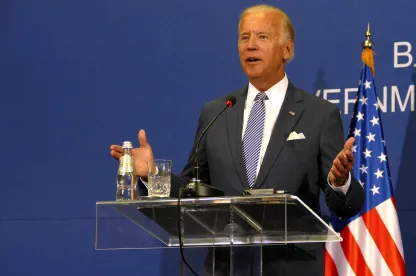Former vice president and presumptive Democratic nominee Joe Biden announced this week the second plank of his economic policy: a clean energy and infrastructure plan, encompassing some of his most progressive policies yet.
In a July 14 speech in Wilmington, Delaware, Vice President Biden announced plans to create “millions of high-paying union jobs by building a modern infrastructure and a clean energy future,” saying that “these are the most critical investments we can make for the long-term health and vitality of both the American economy and the physical health and safety of the American people.” Vice President Biden spoke forcefully of rebuilding American infrastructure through unprecedented investments in clean energy with the two-pronged goal of creating a million new jobs while creating a 100% clean energy economy by 2035.
Biden reiterated a point in his previous economic policy speech about the importance of reinvigorating the American manufacturing sector by creating “good-paying, union jobs.” Discussing the nation’s infrastructure, he noted that one in five miles of American highways are in poor condition; tens of thousands of bridges are in disrepair; and tens of millions of Americans lack access to high-speed broadband. He boasted that his plan would invest billions in construction, engineering, and manufacturing initiatives to address the country’s transportation and broadband systems. He also called for a “second great railroad revolution” to improve access to metropolitan areas. The Vice President said that his infrastructure plan would create hundreds of thousands of jobs and would make American transportation safer, cleaner, and faster for both American citizens and for the exportation of American goods.
Intertwined among his infrastructure proposals were environmental initiatives that he posited would support millions of traditional manufacturing jobs. The Vice President called for 500,000 new electric vehicle (EV) charging stations for new and existing highways, which he said would help American automakers create cars of the future while decreasing consumer gasoline costs. He also called for 60,000 wind turbines, which would be made with American steel and the shipping of which would benefit American ports and shipbuilding facilities.
Echoing previous plans to use the purchasing power of the federal government to promote economic growth, Biden promised to replace the federal government’s entire automotive fleet with EVs, which would boost the automotive industry by providing the demand and the necessary grants. He would also reinstate a “cash for clunkers” initiative for Americans to swap older vehicles for cleaner, American made vehicles. Vice President Biden framed his environmental policies as a strong strategy to counter Chinese market dominance, especially in the fields of clean energy storage and transmission.
The Vice President also spoke passionately about reversing the effects of climate change, noting its disproportionate effects on rural, minority, and low-income communities. He said that 40% of the $2 trillion would go directly to initiatives for these communities. He also promised to reverse President Trump’s environmental regulatory rollbacks; indicated he would seek to hold fossil fuel CEOs accountable for environmental damage; and that he would create a Civilian Climate Corps in the model of President Franklin Delano Roosevelt.
In line with his first major economic policy speech earlier in July, Biden’s second speech made explicit overtures to the progressive wing of the Democratic Party, with commitments to environmental justice, massive public investment and substantive efforts to reverse climate change. As the Democratic convention approaches, Vice President Biden appears to have unified the Democratic Party, with former rivals embracing his recent policy initiatives in all forms of media. Should Vice President Biden win the presidency, Americans should expect the White House to push some of the most ambitious infrastructure and environmental policies in the country’s history.





 />i
/>i

